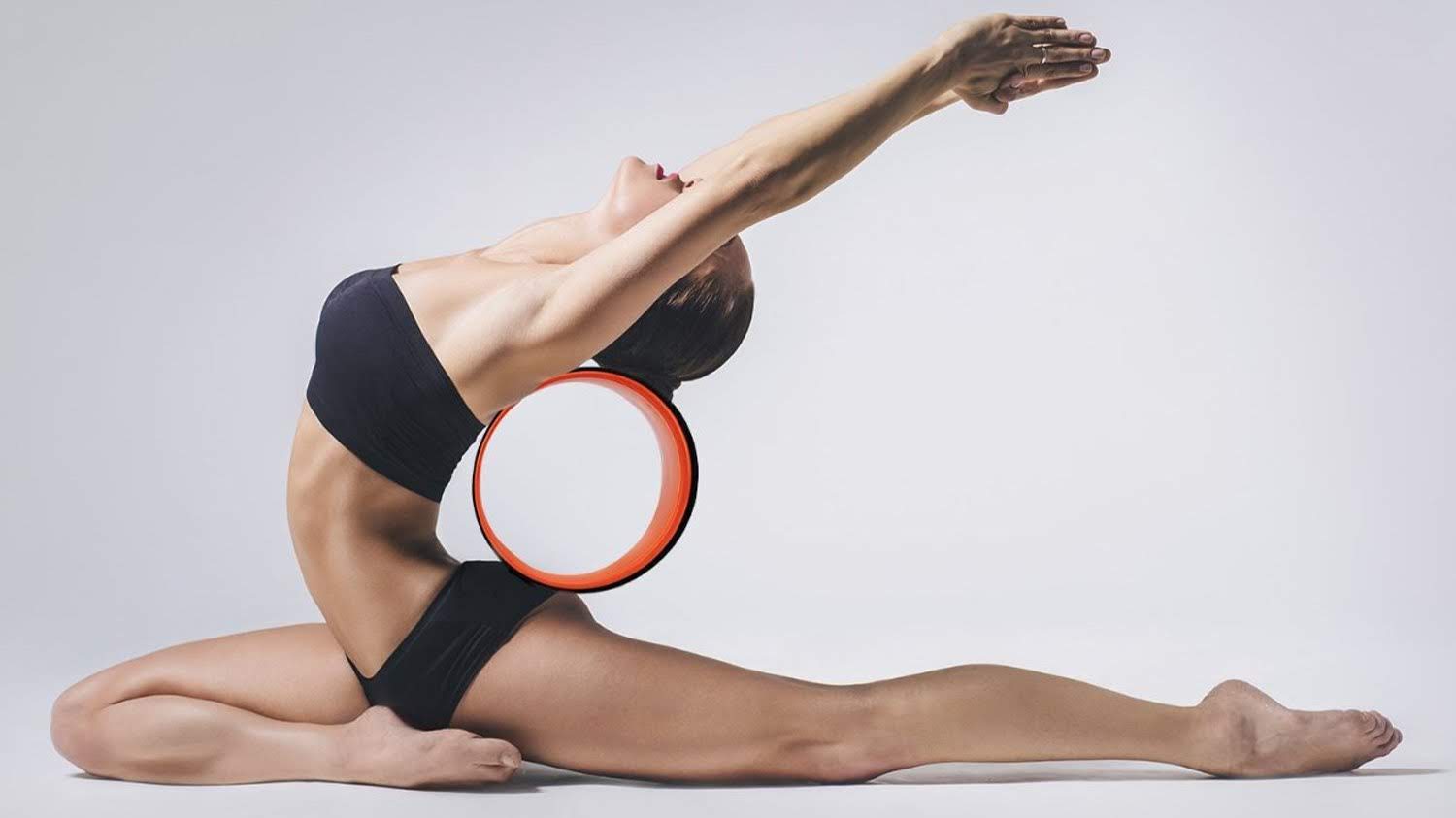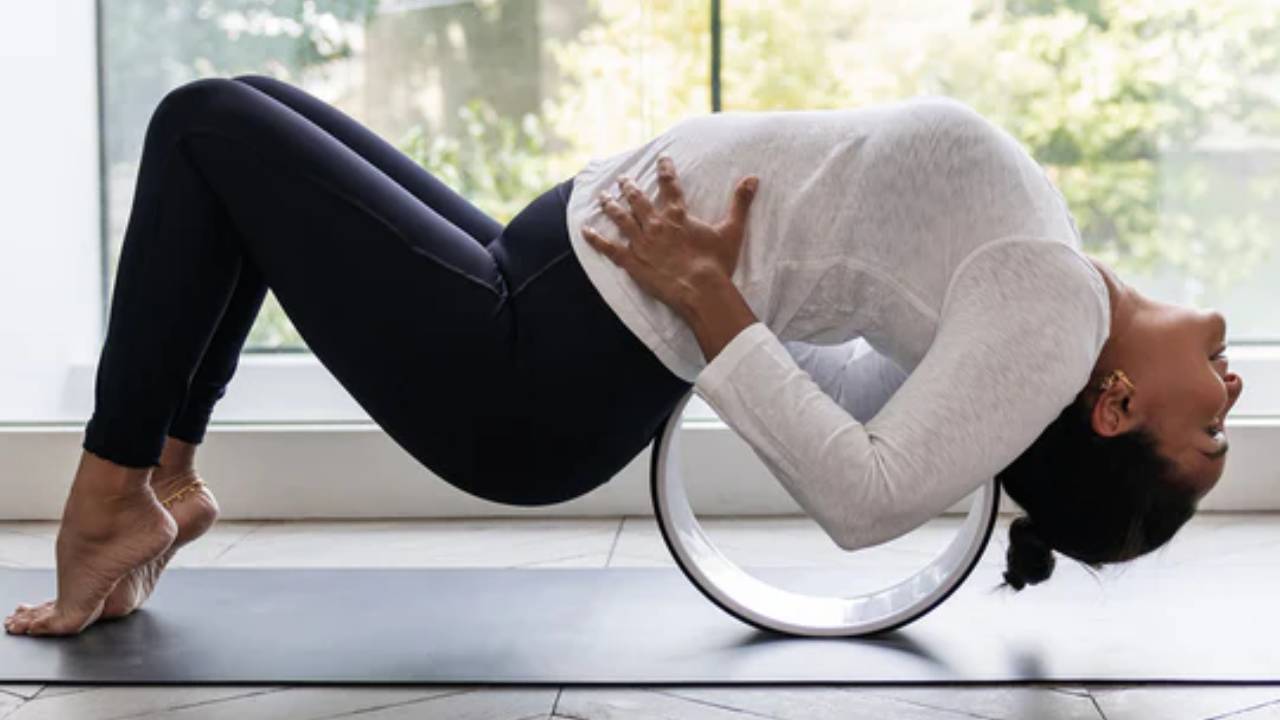How to use a yoga wheel
Learn how a yoga wheel can add a new dimension to your yoga practice

Yoga wheels are just that – a wheel designed as a prop for yoga practices. They are typically made from a form of plastic for the inner ring and coated with various materials for the outer ring. The outer ring may be made from recyclable and sustainable materials such as cork or from soft, non-recyclable materials such as foam.
Designed to be used as a yoga prop, they are very sturdy and can support most of your body’s weight. Unlike yoga blocks that remain stationary as support, yoga wheels can move with you allowing you to explore dynamic postures as well as static ones. Because of their ability to move, they can give a great massage to the back which can help keep your spine healthy. Not only this, but there are many creative ways you can use a yoga wheel to get more from your yoga practice... keep reading to find out more.
- Get started with your practice with the best yoga mats
- Look good in your poses with the best yoga pants
Why would you use a yoga wheel?
Yoga wheels can be used in multiple ways to benefit your body during your yoga practice. They can be used in motion, kept still, for reclined postures, standing postures and even inverted postures such as handstands. The options are many but the main thing to remember is that they are there to aid your yoga practice, offering more support to your body.
Yoga wheels can help you to loosen parts of your body that may not be targeted by other traditional yoga postures. Due to their design, they mold to the shape of your body (depending on how you are using them), as a yoga bolster does but instead of a softer support, yoga wheels firmly support your body. This can help you go deeper into yoga postures, specifically backbends, with confidence that there’s a strong support behind you to hold your weight. They have a comforting effect because of this.
While they may not be everyone’s cup of tea, yoga wheels can be helpful in opening the chest and shoulders, working on spinal flexibility and stretching out the whole front of the torso and hips. These are all areas that can get tight from sitting for long periods of time, or holding onto stress within the body. They have the added benefit of being able to be used in standing postures such as balances, and as a replacement for the yoga block. For example, the wheel can be used in tree pose by placing your foot onto the wheel rather than your inner leg. You can also use the wheel in a standing forward bend to rest your head on to.
4 yoga postures where a yoga wheel can help

1. Headstands
Yoga wheels look like they are designed to only offer support with backbends but this isn’t the case. Yoga wheels can act as support for headstands by placing them behind your head and holding on to the edges. You can do this in the middle of the room or to build your confidence in moving away from the wall, the yoga wheel works well placed against the wall on one side with you holding the other side. This way, you are entering your headstand with the support of the yoga wheel and the wall just behind you while also feeling you are holding your own balance, and helping to build your confidence in moving away from the wall.
Get all the latest news, reviews, deals and buying guides on gorgeous tech, home and active products from the T3 experts
We advise you only try this if you are used to practicing headstand or have a yoga teacher who can help guide you in to it. Please do not try this if you have never done a yoga headstand before.
2. Supported dynamic backbend
If you’re wanting to deepen your backbends, a yoga wheel can really help with that. To do this supported, dynamic backbend you will need to start by sitting on the floor, feet flat on the floor and your yoga wheel behind your back. From here, lift your hips and lean back onto the yoga wheel. Keep pushing into your feet so the yoga wheel moves back, allowing you to come into a table top position. From here, begin to roll along the wheel, massaging the length of the spine. This is the gentle version of this backbend. To go deeper, consider reaching your arms over your head and holding onto the edges of the yoga wheel. This will open the shoulders and deepen the backbend. Play about by lifting your hips up and down to explore the depth of the backbend that suits you. You can hold here or keep shifting the hips up and down to loosen the entire body.
3. Half splits pose
Yoga wheels are commonly believed to be good for reclined postures but you can also use them to support other parts of the body in various, non-reclined postures. Get creative and you can use them for most yoga postures. A yoga wheel can act as a good support for the half splits pose. Starting on all fours, step your right foot forward, balancing your heel on your yoga wheel. Place your hands either side of your leg, and on yoga blocks if needed. Make sure you keep your left hip stacked over your left knee. Point your right toes towards the ceiling. You can hold this here or you can play about by rolling your right leg along the wheel to give a massage to the calf muscle and to deepen the stretch in your hamstrings.
4. Supported reclined thunderbolt
This is a lovely way to access the tricky reclined thunderbolt pose. Many people struggle with this posture, without support, because it stretches the thighs and demands quite a lot from your knees. Not only that but it introduces a lower backbend too! Using the support from the yoga wheel here can take the pressure off your knees and allow you to get all the benefits of this posture without the struggle.
Come to sit on your knees, buttocks off the floor to start with. Separate your feet so you can place your buttocks between your heels. You want to be sat on the floor between your feet, or sat on a yoga block there if you feel pressure in your knees. Have your yoga wheel directly behind you in line with your spine. From here, start to lean back onto the yoga wheel. Your hips can lift slightly to allow you to do this, if that helps. You want to use the yoga wheel to create a backbend while also feeling a stretch through your thighs. If you have this sensation, you are doing the posture!

There are many other yoga postures you can use a yoga wheel for. Why not try and experiment with one in postures like seated forward bend, placing the wheel under your heels lifting your legs off the ground? Or perhaps in a lunge, placing your back foot on top of the yoga wheel to deepen the thigh and hip stretch? Another great option is to place the wheel behind your back while in shoulderstand.
There are so many ways a yoga wheel can add a new dimension to your yoga practice so don’t be afraid to play about and see what works best for you. For more yoga tips, check out how to use a yoga block.
Kat has 10 years of yoga teaching experience with further training in supporting injured students. She is qualified to teach Yin Yoga, Hormone Yoga Therapy and more traditional forms of Hatha yoga. She also has a certificate as a Yoga Therapy Practitioner.